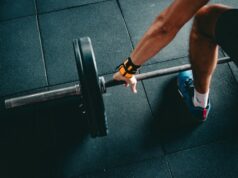Building muscles or getting fit doesn’t just happen in the gym, it occurs during every aspect of your life. You can’t simply hit the gym for a massive lifting session and think that is enough. It is not. When you are working out and lifting heavy weights, you are actually breaking your muscles down and tearing them.
The repeated contraction of your muscles under lots of stress causes tiny tears through the fabric of your muscles. They are broken down in a process known as catabolism.
When you tear the fibres of your muscles in a workout, your body begins to repair them, making them bigger and stronger than they were before. It is this repair and muscle synthesis that makes your workout worthwhile.
This recovery is not easy, however, and you will need to help your body recover as much as possible to increase the effectiveness of your workout, and also to reduce the effects of DOMS.
What is DOMS?
Delayed onset muscle soreness, or DOMS, is that post-workout ache and pain that you get the next couple of days after a big workout. DOMS occurs most often after you start a new exercise regime or increase the intensity of a regular workout.
This is because your muscles are being required to work in a different way than they are used to, or just work harder, which increases the microscopic damage done to your muscle fibres.
DOMS can affect anyone, but is most common for those new to exercise, and although it can put a dent in your enthusiasm, it will subside with time as your muscles get used to their new demands.
You can not completely get rid of DOMS, but there are steps you can take to reduce it which also help improve the recovery of your muscles and maximise the results of your workouts.
Cool Down and Stretching
You should start aiding your recovery before you even leave the gym, through cooling down properly and stretching out your muscles.
During training, metabolic waste products are produced, lactic acid is the most well known, which need to be flushed out from your body. When you finish training, you should keep moving at a gentle pace and bring your heart rate down to resting level.
Listening to music with a slow beat can help bring it down in a safe way. If your heart rate drops too quickly, the extra blood that has been pumped into your muscles during your workout isn’t given a chance to be moved out properly and it will sit there with damaging waste products.
After cooling down you should stretch out the muscles you have been working, this works to counteract the contracting and fibre shortening which happens during training, called adaptive shortening. Post-workout is the best time for stretching as your muscles are already warm and supple, meaning they can be stretched further and with less risk of injury.
You should do static stretches after a workout and hold them for at least 20 seconds at the point where it feels tight. Stretching also helps improve your results in the long term as you will be maximising your mobility, meaning you will be able to work your muscles out for a larger range of motion, such as safely squatting deeper.
Eat Plenty of Carbohydrates After your Workout
Many people think that all you need to improve your workout recovery and results is protein. However, carbohydrates are also vital to your metabolic processes.
Chemical energy is stored in the form of glycogen, which is converted into glucose when you are training to give your muscles energy. Glycogen also generates adenosine tri-phosphate (ATP) which is vital for carrying energy to your muscles, and aiding in their contraction.
After your workout, your glycogen levels are significantly decreased and need to be replenished so that you can get stronger and have the energy perform at a higher level the next time you workout, which is how your muscles continually get bigger.
Low carbohydrate diets have also been shown to decrease your testosterone levels, which in turn will reduce the amount of weight you can lift when training.
Protein
There is a huge obsession with post-workout protein shakes, and you may have heard of something called the ’30 minute anabolic window’. This theory has been disproven.
Your muscle synthesis rates are actually improved for up to 36 hours after a workout. On top of this, there have been studies which have shown that the protein you consume before a workout has a larger impact on protein synthesis rates than the same amount of protein would afterwards.
This greater anabolic response is down to the fact that your body takes time to digest and process the food you eat, and therefore you would be getting the benefits of the protein during, and immediately after your training session.
Therefore, you should eat a meal containing both protein and carbohydrates 1-2 hours before you train, or if you like to train on an empty stomach then perhaps just a protein shake.
Use a Foam Roller
Foam rollers have had a surge of popularity recently as people have started to realise the great benefits they can have. Foam rollers will enhance your recovery as well as improving your performance. Foam rolling has a similar effect to receiving a massage, it helps stimulate the blood flow through the areas you roll out.
It is great at reducing soreness and knots as well. While your muscles are being trained or in recovery mode, they can become tight and knotted causing stiffness, pain, and lower levels of elasticity. Rolling out your muscles break up these knots and push oxygenated blood into these tight areas.
You can also improve your mobility using a foam roller, again allowing you to work out more effectively in the future.
Get Plenty of Sleep
When you are asleep, you are not just allowing your brain to rest, your whole body goes into recovery mode. Your body is doing nothing but recovering when you are sleeping, and this is when your muscles repair the most.
Getting enough sleep also works to greatly improve your testosterone levels, allowing you to make maximum gains in the next workout.
Another reason for ensuring you get plenty of sleep is that if you don’t, you will not be as mentally strong and will not be able to work out and push yourself as hard.
Stay Relaxed
Sleep is not the only time you need to try and stay as relaxed as possible. If you are stressed out during the daytime, you are negatively impacting your muscle restoration. Stress also reduces your testosterone levels as you produce a hormone called cortisol, which inhibits your testosterone production.
This drop is temporary. However, if you are always stressed out, you will have a permanently lower testosterone level, and will not be able to recover and work out effectively.
Author’s Bio
ADV Research, based in Melbourne, Australia, provides the latest in sports supplementation for athletes. With state-of-the-art technology and a world class research and development team, ADV Research’s passion lies in providing their loyal users ground-breaking gains without the side effects.












